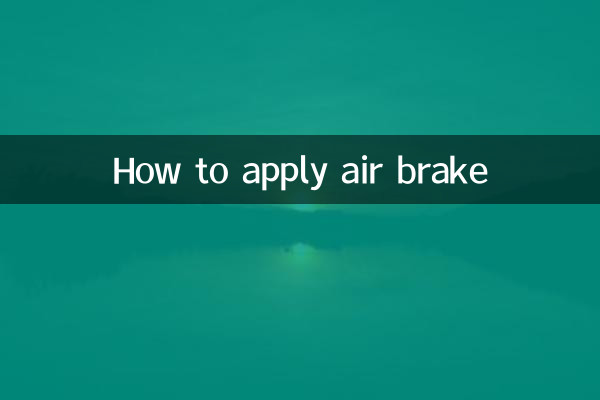How to apply air brakes: hot topics and operation guides on the Internet in the past 10 days
In the hot content on the Internet in the past 10 days, the topic of vehicle safety driving continues to heat up, especially the air brake operation of large vehicles has become a hot topic. This article combines hot topic data with practical tips to provide a structured guide for novice and professional drivers alike.
1. Hotspot data related to weather braking in the past 10 years across the entire network

| Ranking | keywords | Search volume (10,000) | Main discussion platform |
|---|---|---|---|
| 1 | Air brake principle | 28.5 | Zhihu/Truck Home |
| 2 | Semi-trailer braking skills | 19.2 | Station B/Douyin |
| 3 | Brake failure emergency treatment | 15.7 | Weibo/Kuaishou |
| 4 | The difference between air brakes and oil brakes | 12.3 | Tieba/Understanding Car Emperor |
2. 5 steps to correctly apply the air brake
1.Anticipate deceleration: The air brake system has a response delay of about 0.3 seconds. It is recommended to predict the road conditions in advance and start braking 2-3 seconds earlier than ordinary cars.
2.Gradual pressure: Adopt the "two-stage stepping method" - first step lightly for about 1/3 of the stroke to activate the brake chamber, and then continue to increase the intensity after the air pressure gauge pointer begins to drop.
3.Maintain pedal angle: The optimal pedaling angle is 60-75 degrees, with the toes aligned with the center of the pedal to avoid slipping.
4.With auxiliary braking: The engine retarder should be used simultaneously when going downhill, which can reduce brake pad wear by up to 40%.
5.Emergency braking techniques: In an emergency, pedaling twice in quick succession (with an interval of 0.5 seconds) can trigger the optimal working state of the ABS system.
3. Air pressure control parameters in different scenarios
| scene | Recommended air pressure (bar) | duration | Risk warning |
|---|---|---|---|
| Conventional braking on flat roads | 4-5 | Continue until parking | Lower than 3.5bar requires immediate maintenance |
| Slow down on long slopes | 6-7 | intermittent use | It may be overheating if it lasts for more than 10 seconds. |
| Emergency braking at full load | 7-8 | ≤3 seconds | There is a pulsing sensation when ABS is triggered |
4. Analysis of recent accident cases
According to the latest report from the transportation department, two of the three major truck accidents that occurred in the past 10 days were directly related to improper air brake operation. The main manifestations are: forced driving when the air pressure is insufficient (Case 1), and continuous downhill without using auxiliary braking, resulting in thermal attenuation (Case 2). These cases once again verify the importance of standardized operations.
5. Maintenance points
1. Check whether the air pressure gauge is within the normal range of 7-8bar before leaving the vehicle every day.
2. Drain the accumulated water in the air tank at least once a month
3. Replace desiccant every 50,000 kilometers
4. If you hear the sound of air leakage, stop the vehicle immediately for maintenance.
Mastering the correct air brake operating technology can not only ensure driving safety, but also extend the life of the brake system. It is recommended that novice drivers conduct more than 20 simulation trainings under no-load conditions to gradually develop muscle memory. Remember: The key to safe braking is anticipation and gentle operation, rather than relying on emergency braking.

check the details

check the details